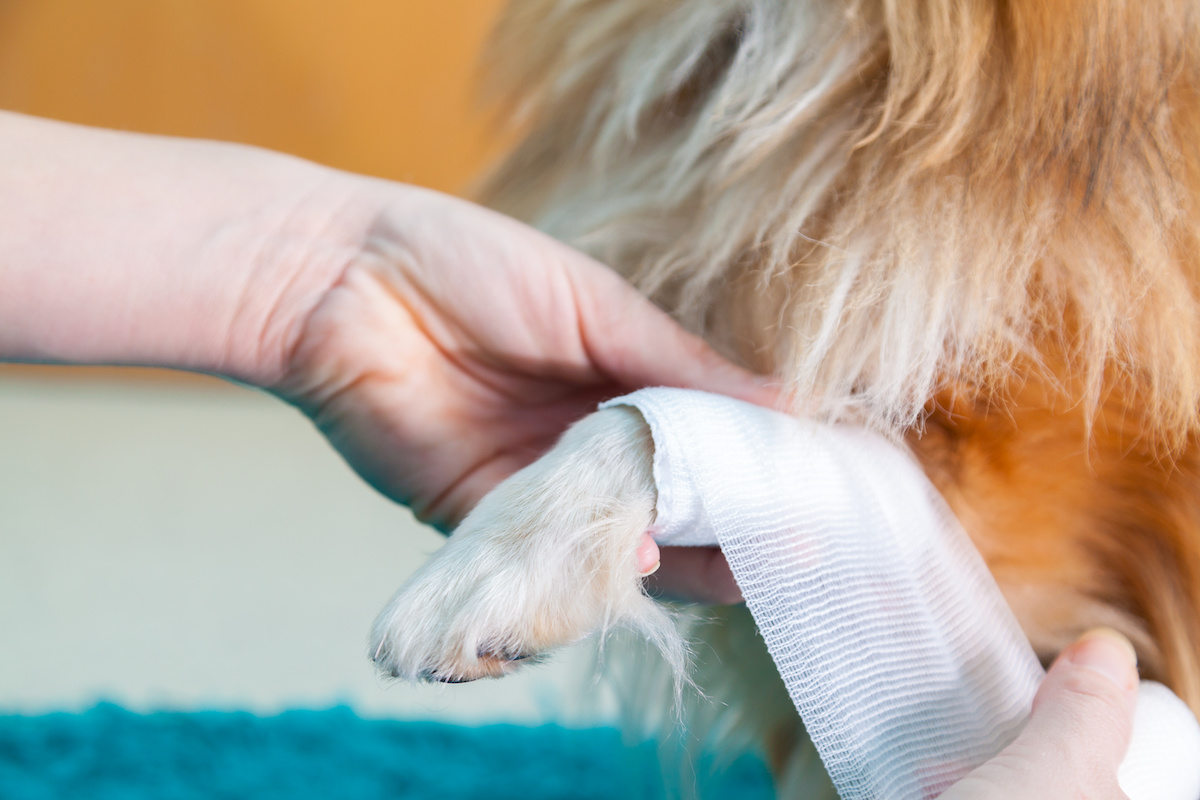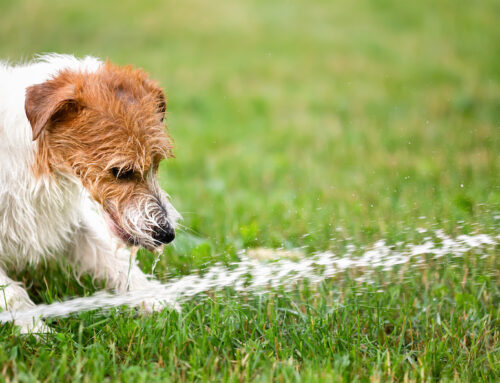Pet emergencies can happen anywhere and at any time, so it’s important to be prepared. Basic first aid knowledge can help you treat minor injuries or keep your pet safe until you can get your pets proper medical care.
Not all injuries can be treated at home, so it’s key to know when to seek professional help. Keep your emergency kit stocked with the items listed here, so you’re prepared for any situation. You never know when you’ll need to help a pet in need.
What is First Aid for Pets?
First aid is a form of emergency medical care that helps prevent, manage, or treat a disease or condition in animals. It can be administered by a veterinarian, a licensed pet technician, or by anyone with a basic understanding of how to care for animals.
Pet first aid, also called veterinary clinic first aid, covers a range of veterinary procedures and treatments, from how to administer a needle to how to handle a severe seizure. Having basic first aid knowledge for pets can help save a life.
Why is Pet First Aid Important?
Pets are a member of the family, and just like people, they can get sick. Being prepared for an emergency can make all the difference if your pet encounters an injury or illness. Even a minor cut or scrape can quickly lead to serious complications if left untreated. In addition to preventing serious injury, caring for minor ailments can improve your bond with your pet. It’s important to remember that your furry family member relies on you for their health and well-being.
Some emergencies will require you to seek professional help. For example, if your pet suffers from seizures or needs assistance breathing you should contact a licensed veterinarian, but proper first aid knowledge will help you care for your pet until you can get them to the clinic.
What You Can Do to Be Prepared for a Pet Emergency
The best thing you can do to be prepared for a pet emergency is to keep your pet healthy. Just like with people, regular checkups are a great way to make sure your pet maintains a healthy weight and stays active. Preventative visits to the vet mean you’re less likely to need to call them in an emergency.
Watch your pet for signs of illness. Even simple behavior changes, like excessive sleeping or eating, can indicate an underlying illness.
Create a kit containing basic pet first aid supplies including:
- A list of important phone numbers such as your veterinarian, the nearest emergency vet clinic, and Animal Poison Control.
- Copies of your pet’s veterinary records, including immunizations and current medications.
- Wound care supplies including gauze, non-stick bandages, scissors, clean towels or rags, gentle cleaning solution, and antibacterial ointment.
- Vomit-inducing medications such as Milk of Magnesia, activated charcoal, or 3% hydrogen peroxide. (Never administer these medications without speaking to a vet or poison control first!)
- A “fever thermometer” designed specifically for pets.
- A muzzle, spare leash, and cone collar
If you end up in an emergency you’ll be glad you didn’t have to scramble to find the supplies you need.
Basic First Aid for Your Pet
Now that you know all of the important reasons why you need to know about basic first aid for your pet, let’s talk about the techniques you should learn. Here are some basic first aid approaches for both dogs and cats.
What to do if Your Your Pet is Choking
If you notice your pet gulping for air, check to see if they are choking. You may be able to remove the obstruction from its mouth, however, refrain from sticking your finger down your pet’s throat as this can cause damage or lodge the object further inside.
If you aren’t able to clear the obstruction, there is a method to perform the Heimlich Maneuver on cats and dogs:
- Hold your pet’s back against your stomach (head up, paws down).
- With one hand, find the soft hollow under the ribs (your closed fist should fit into this spot).
- Use the hand on your pet’s stomach to pull up and in, toward your own stomach, 2-3 times using a sharp thrusting motion.
- Check the mouth to determine if the object has been dislodged.

How to Handle Wounds on Cats and Dogs
Wounds on pets can be scary, but they don’t have to be a cause for major concern. In most cases, a small cut on your dog or cat can be treated at home.
- If the wound is bleeding, use a clean towel and apply gentle pressure until it stops. If you have trouble getting the wound to stop bleeding, it may be too deep to treat at home. Consult your veterinarian.
- Examine the wound and use tweezers to carefully remove any dirt or debris such as glass or thorns.
- Clean the wound using diluted betadine or chlorhexidine, if you don’t have these on hand, gentle soap and water should do the trick. Never use alcohol or peroxide as this can damage sensitive tissue.
- Apply antibacterial ointment such as Neosporin and cover with sterile bandages.
- If your pet tries to chew the bandages or lick the wound you may need to consider a cone collar until their wound heals.
Infection is the biggest risk for wounds. Keeping your pet’s wound clean and minimizing stress as much as possible is key to healing well.
Tending to Pets with Seizures
What should you do if your pet has a seizure? It’s important to know the signs of a seizure so you can respond quickly.
Some of the most common signs of a seizure include:
- acting abnormally lethargic
- walking stiffly
- shaking
- staring into space
- falling
- chewing or licking at the ground
- drooling
- urinating or defecating
If your pet begins to have a seizure, move the pet to a safe location away from stairs or other hazards, and then maintain a safe distance. Pets may become disoriented during a seizure and bite or scratch you uncharacteristically.
Pets with certain medical conditions, such as hypoglycemia, hypothyroidism, or low blood sugar, may have seizures. If this is the case, be sure to follow the diet recommended by your veterinarian to keep your pet’s blood sugar within a healthy range and administer any medications that may be prescribed.
Dealing with Dental Emergencies in Pets
What should you do if there is a dental emergency with your pet?
First, identify the situation. Does your pet have a broken tooth? A foreign object lodged in his gum? Have there been any changes in your pet’s eating or drinking habits?
Next, keep your pet calm and comfortable. You can try using a heating pad or cool misting system to help reduce swelling and pain. If your pet is in pain, contact your veterinarian to discuss pain medication options.
Clean your pet’s teeth regularly, feed them a healthy diet, and pay attention to loose or missing teeth. Watch for signs of decay and take your pet for their yearly check-up where their teeth will also be examined.
Many dental discomforts have a simple fix, but serious or chronic issues may require dental surgery.
When to Call the Veterinarian
Although there are times with pet first aid is sufficient, more serious illnesses or injuries should always be evaluated by a veterinarian.
Call your vet if any of the following symptoms in your pet:
- Sudden changes in behavior such as unusual aggression, lethargy, or irritability
- Changes in eating or drinking habits such as disinterest in food or excessive thirst
- Evidence of broken bones such as limping or pain that lasts longer than a few hours
- A wound that won’t stop bleeding or appears infected
- Unexplained signs of illness such as panting, pacing, stumbling, or weakness
If your pet shows signs of a serious injury or illness, call the veterinarian immediately.
Pet First Aid: Schedule a Health & Wellness Checkup with Animal Care Center
The best form of first aid is preventative care. Schedule a wellness checkup with your veterinarian to check your pet’s blood pressure, heart rate, weight, and teeth. You can also ask us any questions you have about your pet’s health or how to handle first aid situations.






